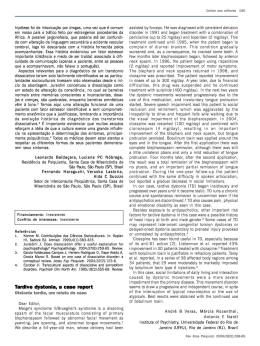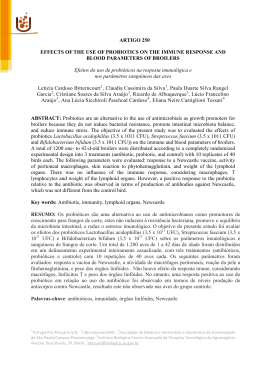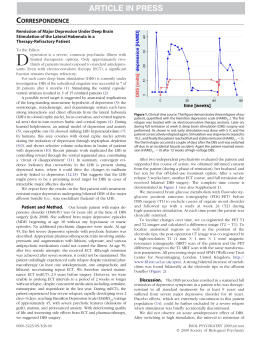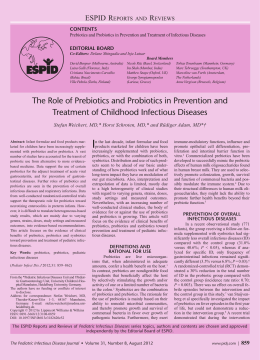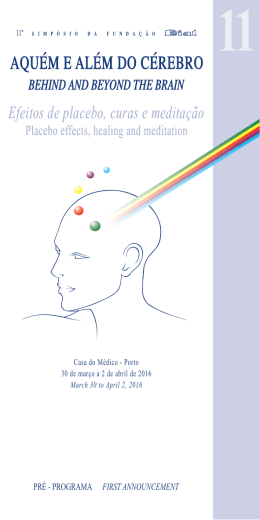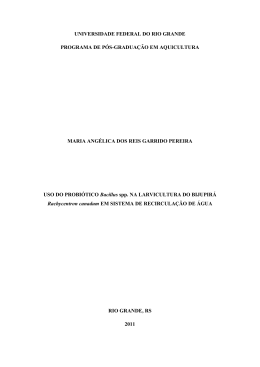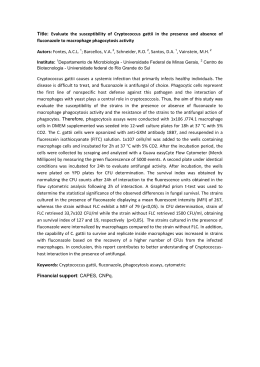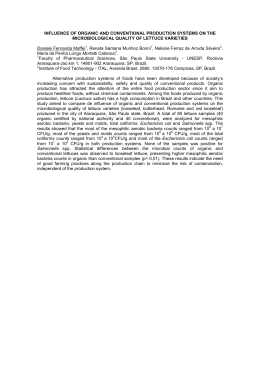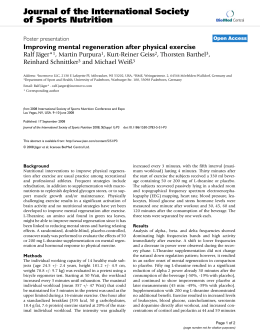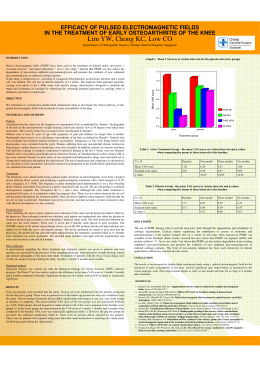PRESENTATION Probiotics in the Treatment of Human Inflammatory Bowel Diseases Update 2011 Bartolomeus Joannes Meijer, MSc and Levinus Albert Dieleman, MD, PhD Abstract: Crohn’s disease, ulcerative colitis, and pouchitis after ileal pouch anal anastomosis in ulcerative colitis patients are often refractory to standard therapy. Over the last decade, the rational to use probiotics and its beneficial efficacy in the treatment of chronic inflammatory bowel disease (IBD) is increasingly under scrutiny. Although it has become clear that intestinal epithelial-mucosal immune interactions and enteric bacteria play a critical role in the development of IBD, the substantial clinical efficacy of probiotics in these disorders is less evident. This review outlines the clinical studies regarding probiotics before October 2007. These studies formed the foundation of probiotic clinical trials in IBD, but they also indicated the need of larger and better-controlled studies than the past experimental approaches. Furthermore, this review also examines in-depth the probiotic clinical trials published between 2007 and December 2010, providing new insights into the role of probiotics for inducing and maintaining remission of IBD, and highlighting some of the breakthroughs, especially regarding induction of remission for ulcerative colitis. Key Words: Crohn’s disease, inflammatory bowel diseases, pouchitis, probiotics, ulcerative colitis, lactobacillus, bifidobacterium, intestinal bacteria (J Clin Gastroenterol 2011;45:S139–S144) S ince 1997, when the treatment of chronic inflammatory bowel disease (IBD) with Escherichia coli Nissle 19171,2 was studied, probiotic treatment for human IBD, including pouchitis, has been investigated and reviewed numerously. At present, accumulating evidence suggests that the dynamic balance between microbes, particularly commensal flora, and host defensive responses at the mucosal frontier has a pivotal role in the initiation and pathogenesis of chronic IBD.3 In addition, susceptibility genes and environmental agents have shown importance in a dysfunctional mucosal immune system in IBD. Despite an increased understanding of its pathogenesis, the present therapies are still relatively insufficient to cure IBD. Patients often become intolerant or refractory to standard treatments, some of them with significant adverse effects. As a result, novel treatments have been studied to abrogate patients’ debilitating symptoms. Some of the alternative treatment options have included modulation of the intestinal microflora using probiotics. The aim of this review is to provide a brief historical perspective of the available evidence for the use of probiotics in IBD followed by a recent update of the literature. The intent is to enhance the clinician perspective about the role of probiotic therapy within the array of conventional medical treatments. LITERATURE SEARCH A systematic literature search was conducted in the following databases: EMBASE, BIOSIS Previews, Medline, and PubMed. The following terms were used for searching: Crohn’s disease, ulcerative colitis, pouch, pouchitis, inflammatory bowel diseases, and probiotic. Search results were separated into 2 groups with the first group consisting of results published before October 2007, and the second group consisting of publications from 2007 through December 2010. Results were restricted to human patients, written in the English language, and original research articles using only larger randomized controlled trials (RCT). OVERVIEW OF PROBIOTIC CLINICAL STUDIES FOR IBD BEFORE OCTOBER 2007 Crohn’s Disease (CD) For CD, a total of 9 studies were conducted before October 2007. However, only 2 small studies were associated with inducing remission for CD.4,5 Maintenance of Remission From the Department of Medicine, Center of Excellence for Gastrointestinal Inflammation and Immunity Research, University of Alberta, Edmonton, Canada. Dr L.A. Dieleman is supported by Canadian Institutes of Health and Research (CIHR), Crohn’s and Colitis Foundation of Canada (CCFC), and by the Broad Medical Research Program. Dr Dieleman is also a member of the Alberta Inflammatory Bowel Disease Consortium, funded by Alberta Innovates Health Solution. Dieleman is a consultant for Abbott Canada, Merck Canada Inc., Ferring and Abbott Nutrition. He has received research support from Beneo-Orafti. The other author declares that he has nothing to disclose. Reprints: Levinus Albert Dieleman, MD, PhD, University of Alberta, Division of Gastroenterology, 2-24 Zeidler Ledcor Centre, Edmonton, AB T6G 2 8, Canada (e-mail: [email protected]). Copyright r 2011 by Lippincott Williams & Wilkins J Clin Gastroenterol Bousvaros et al6 reported no significant difference in probiotic efficacy [4 1010 colony forming units (CFU)] when compared with a placebo. In this RCT, 18 of the 75 patients relapsed, 33% of these relapsing patients had earlier surgery, 22% had not. Guslandi et al7 randomized 32 patients to either treatment with Saccharomyces boulardii or mesalamine (3 g/d). Both research arms were homogenous for previous bowel resection, the probiotic group showed an increased time to relapse relative to the mesalamine control group.7 In a 1-year trial in patients who did not undergo surgery,2 oral administration of E. coli Nissle 1917 did not significantly increase the time to relapse relative to placebo. Volume 45, Supp. 3, November/December 2011 www.jcge.com | S139 Meijer and Dieleman J Clin Gastroenterol Volume 45, Supp. 3, November/December 2011 Prevention of Postoperative Relapse Pouchitis Prantera et al8 reported no significant difference in probiotic efficacy (Lactobacillus GG, 1.2 1010 CFU) when compared with a placebo. Similarly, Marteau et al9 and van Gossum et al,10 respectively, reported that Lactobacillus johnsonii did not prolong the time to relapse after surgery for CD, indicating that this probiotic strain was ineffective for maintenance therapy in CD, although these results were weakened due to a high dropout rate. In addition, a synbiotic preparation was studied by Chermesh et al11 in 2007, who conducted a RCT to examine the efficacy of Synbiotic 2000 (a commercial mixture containing 4 probiotics and 4 prebiotics) to extend the duration of remission after surgery for CD. This was a small study and also suffered from a lot of dropouts. During this 2-year follow-up, there were no significant differences with respect to either endoscopic or clinical relapses. However, the majority of patients had fistulizing CD, and their response to this treatment may differ from those who have inflammatory nonpenetrating disease behavior.11 Pouchitis is a relatively common occurrence in patients with UC who undergo ileal pouch anal anastomosis after colectomy. Trials examining the use of probiotics for inducing remission of pouchitis have either been too small or uncontrolled to draw any conclusions regarding probiotics.21–23 In maintaining remission, probiotic therapy was beneficial in all larger placebo-controlled studies using VSL#324–27 and 1 study using Lactobacillus rhamnosus GG.28 Each study found significant improvements in extending the time to relapse. In fact, the placebo-controlled study by Gionchetti et al26 was the first report on the efficacy of probiotics for an indication related to IBD (Table 1). Ulcerative Colitis (UC) Two large randomized controlled studies examining probiotic treatment for inducing remission in UC concluded that there were significant reductions in disease activity relative to the control groups.12,13 One of these studies, conducted by Tursi et al,12 studied the efficacy of balsalazide and a high potency probiotic mixture (VSL#3) and compared it to a group-administered balsalazide, or to a group-administered mesalamine. The combination treatment was most effective; it outperformed the comparator groups on symptoms assessment, endoscopic appearance, and histologic evaluation. The other study on preventing mild-to-moderate UC flares, conducted by Matthes et al,13 explored the effect of dosing probiotics, randomizing 90 patients to either 40 mL, 20 mL, or 10 mL enemas containing E. coli Nissle 1917 (1 108 CFU/mL) or placebo, concluding that remission rates significantly decreased according to dosing; 53%, 44%, and 27%, respectively.13 A third large randomized controlled study concluded that probiotic treatment was as effective as the standard mesalamine treatment,14 but this study suffered from a subtherapeutic mesalamine dose in the control group. In addition, findings on reductions in disease activity when comparing probiotics to a mesalamine control group were supported by Kato et al15 in a smaller RCT and in 2 openlabel studies.16,17 For maintaining remission, 2 studies concluded independently that E. coli Nissle 1917 did not significantly increase the time to relapse1,14 versus 1.2 or 1.5 g/d mesalamine. A third larger study also found that the same probiotic strain was as effective as the control group receiving mesalamine (significant equivalence, P=0.003).18 The low dose of mesalamine in the control group may have generated a “placebo” effect, thereby casting doubt as to the efficacy of E. coli treatment for this indication. Two large studies using Lactobacillus salivarius or Bifidobacterium infantis did not show significant difference in preventing UC relapse versus placebo or 2.4 g mesalamine,19,20 but Zocco et al20 concluded that Lactobacillus GG did prolong the length of remission. A combination of this probiotic and mesalamine did not induce a synergistic therapeutic effect on the trial patients. S140 | www.jcge.com CLINICAL STUDIES FROM OCTOBER 2007 THROUGH TO DECEMBER 2010 CD Induction of Remission No RCTs were found in which probiotics were used to induce remission in patients with CD. Maintenance of Remission There were no studies regarding probiotics to prevent relapses in patients with CD. However, it is noteworthy to mention that Vilela et al29 researched the effects of Saccharomyces boulardii on the intestinal permeability of patients with CD in remission. A small RCT with 15 patients on S. Boulardii versus 19 patients on placebo demonstrated that patients treated with S. Boulardii and who remained in remission also improved their abnormal intestinal barrier function. UC Induction of Remission Adding to open-label studies reported by Bibiloni et al17 and Tursi et al12 on the beneficial therapeutic effect of VSL#3 in inducing remission for UC, Sood et al30 performed a large randomized placebo-controlled trial in 2009 on adults with mild-to-moderate activity of UC, administering 3600109 CFU of VSL#3. Concomitant treatment with oral mesalamine, azathioprine, or 6mercaptopurine, was continued on a stable dose. After 12 weeks of treatment the remission rates in VSL#3 versus placebo were 42.9% and 15.9%, respectively. Although this study was well designed, a large dropout in the placebo group (20%) was an important limitation for this study. Tursi et al31 randomly assigned 144 adults with relapsing mild-to-moderate UC to either 3600109 CFU of VSL#3 or placebo, as an adjunct to standard maintenance treatment. Although there were no significant differences in obtaining clinical remission, there was a significant clinical response in the VSL#3 group. In addition, VSL#3 was investigated in children. Miele et al32 studied the efficacy of VSL#3 in adjunct to standard treatment with steroids and 5-aminosalicylic acid in the induction and maintenance of remission in 29 newly diagnosed patients with UC in a small randomized placebocontrolled trial. After steroid induction therapy, a high induction remission rate (92.8%) was achieved in patients on VSL#3 (dose range from 450 to 1800 109CFU based on age) while on a stable dose of oral 5-aminosalicylic acid. In the placebo group, only 36.4% of patients obtained clinical r 2011 Lippincott Williams & Wilkins J Clin Gastroenterol Volume 45, Supp. 3, November/December 2011 Probiotics for the Treatment of IBD TABLE 1. Summary of Studies Investigating the Effect of Probiotic Treatment on the Induction and Maintenance of Remission in Inflammatory Bowel Disease Published Before October 2007 Group (Dose/d) First Author Design Duration Crohn’s Disease Maintenance of remission Bousvaros et al6 DB, R, C 2 y Probiotic Comparator LGG (4 1010 CFU) n=39 Placebo n=36 LGG (1.2 1010 CFU) n=23 Lactobacillus johnsonii LA1, Nestle (2 109 CFU) n=43 Placebo n=22 Concomitant Therapy Aminosalicylate 6-MP, azathioprine, corticosteroids Loperamide, cholestyramine Loperamide, cholestyramine, corticosteroids tapered to nil by week 3 None Prantera et al8 DB, R, C 1 y Marteau et al9 DB, R, C 6 mo Van Gossum et al10 DB, R, C 12 wk Lactobacillus johnsonii Placebo n=22 LA1, Nestle (1 1010 CFU) n=27 R, C 8 wk Balsalazide (2.25 g) and VSL#3 (1 1011 CFU) n=30 Balsalazide (4.5 g) n=30 Mesalamine (2.4 g) n=28 None Matthes et al13 DB, R 4 wk E. coli Nissle 1917 (>108 CFU/mL) 10, 20, or 40 mL Enema n=20 Placebo n=20 None Rembacken et al14 DB, R, C 1 y E. coli Nissle 1917 (1 1011 CFU) n=57 Mesalamine (2.4 g) n=59 Prednisolone or hydrocortisone enemas E. coli Nissle 1917 (CFU >1010) n=50 E. coli Nissle 1917 (CFU>1010) n=39 E. coli Nissle 1917 (2.525 109 CFU) n=162 L. salivarius or Bifidobacterium infantus (1 109 CFU) n=52/group Mesalazine (1.5 g) n=53 Mesalamine (1.2 g) n=44 Mesalamine (1.5 g) n=165 None Placebo n=53 Aminosalicylate VSL#3 (1 1011 CFU) n=20 VSL#3 (6 g) n=20 Placebo n=20 None Placebo n=20 None L. GG (CFU >1010) N=78 Placebo n=39 Not indicated Ulcerative colitis Induction of remission Tursi et al12 Ulcerative Colitis Maintenance of remission Kruis et al1 DB, R, C 3 mo Rembacken et al14 DB, R, C 1 y Kruis et al18 DB, R, C 1 y Shanahan et al19 DB, R, C 1 y Pouchitis Maintenance of remission Gionchetti et al25 DB, R, C 12 mo Gionchetti et al26 DB, R, C 9 mo Gosselink et al28 R, C 3 y Placebo n=47 Results Prednisolone (tapered to nil over 4 mo) None NSD NSD NSD for endoscopic scores NSD for endoscopic score High dropout rate (n=21) Balsalazide and VSL#3 outperformed the 2 comparator groups (symptoms assessment, endoscopic appearance, and histologic evaluation) Remission induced in 18.2% (placebo), and varied by dose in the treatment group: 27.3% (10 mL); 44.4% (20 mL), and 52.9% (40 mL) As effective as mesalamine at attaining remission NSD for relapse rates, CAI scores, global assessment NSD As effective as mesalamine at maintaining remission (P=0.003) NSD Increased duration of remission (P <0.05) Increased duration of remission (P <0.001) Increased duration of remission (P=0.011) VSL#3: commercial mixture containing Bifidobacterium longum, B. infantis, B. breve. Lactobacillus acidophilus, L. casei, L. delbrueckii subsp bulgaricus, L. plantarum, and Streptococcus salivarius subsp thermophilus. C indicates controlled; CAI, clinical activity index; CFU, colony forming units; DB, double-blind; L.GG, Lactobacillus rhamnosus GG; L. salivarius, Lactobacillus salivarius subsp Salivarius UCC118 strain; MP, mercaptopurine; NSD, no significant difference; R, randomized. remission. VSL#3 was well tolerated in both adults and children. In 2004, Tursi et al12 studied a dose effect of E. coli Nissle 1917 for the induction of remission. A larger trial by r 2011 Lippincott Williams & Wilkins Matthes et al33 confirmed Tursi previous findings; time to remission was indeed shortest in the E. coli Nissle 1917 40 mL high-dose group. However, this trial was hampered by the high number of excluded patients. www.jcge.com | S141 J Clin Gastroenterol Meijer and Dieleman Maintenance of Remission Volume 45, Supp. 3, November/December 2011 corticosteroid induction or response. A relapse was defined if the Lichtiger colitis activity index score had increased >3 points. The relapse rate was 73.3% in the placebo arm. In 2009, Miele et al32 reported that 21.4% of the children treated with VSL#3 relapsed within 1 year after TABLE 2. Summary of Studies Investigating the Effect of Probiotic Treatment on the Induction and Maintenance of Remission in Inflammatory Bowel Disease Published After October 2007 Group (Dose/d) First Author Date Design Duration Crohn’s Disease Maintenance of remission Vilela et al29 DB, R, C 3 mo Probiotic Comparator Concomitant Therapy S. Boulardii (4 108 CFU) n=15 Placebo n=19 Healthy controls n=15 Mesalamine, Azathioprine Prednisone, metronidazol/ thalidomide DB, R, C 12 wk VSL#3 (3.6 1011 CFU) n=77 Placebo n=70 Mesalamine, Azathioprine, 6-MP Tursi et al31 DB, R, C 8 wk VSL#3 (3.6 1012 CFU) n=71 Placebo n=73 Miele et al32 DB, R, C 1 y VSL#3 (4, 5-18 109 CFU) n=14 Placebo n=15 Matthes et al33 DB, R, C 4-8 wk EcN (1 108CFU/ mL) Group 1=40 mL n=24 Group 2=20 mL n=23 Group 3=10 mL n=23 Placebo n=20 VSL#3 (4, 5-18 109 CFU) n=14 Placebo n=15 Mesalamine, Corticosteroids Bifidobacterium longum (2 109 CFU) n=40 Synbiotic N=40 Prebiotic (psyllium 4 g) n=40 Aminosalicylate prednisolone VSL#3 (3.9 1011 CFU) n=18 No treatment (control) n=13 None Ulcerative colitis Induction of remission Sood et al30 Ulcerative colitis Maintenance of remission DB, R, C 1 y Miele et al32 Fujimori et al34 R, C 4 wk Pouchitis Maintenance of remission O, R, C 12 mo Pronio et al35 Results Improved permeability (P=0.0005) and maintenance of remission 6wk Decreased UCDAI>50% in 32.5%VSL#3 vs. 10% in placebo (P=0.001). 12 wk Decreased UCDAI >3 in 51.9% VSL#3 vs. 18.9% placebo (P<0.001). 42.9% remission in VSL#3 vs. 15.7% in placebo (P<0.001). Mesalamine, Azathioprine, UCDAI >50% decrease in 6-MP 63.1% VSL#3 vs. 40.8% placebo (P=0.01). Decreased UCDAI>3 in 60.5% VSL#3 vs. 41.4% placebo (P=0.017). NSD for remission and endoscopic scores Mesalamine, SteroidRemission induced by induction therapy corticosteroids in 92.8% (VSL#3) vs. 36.4% (placebo) (P<0.001). Lower endoscopic and histologic scores (P<0.05) Aminosalicylate Dose-dependent remission, Corticosteroisds resp.; 52.9%, 44.4%, 27.3%, Loperamide drops 18.2% (P=0.0446) Shorter time to remission in 40 mL and 20 mL vs. 10 mL and placebo Relapse within 1 y in 21.4% (VSL#3) vs. 73.3% (Placebo) (P=0.014) Lower endoscopic and histologic scores (P<0.05) NSD IBDQ compared with baseline for probiotics Improvement in IBDQ with symbiotic (P=0.04) Decreased PDAI (1.5 to 0.3) after 3,6, and 12 mo in patients on VSL#3 (P<0.01) Increased T-reg. cells. VSL#3: commercial mixture containing Bifidobacterium longum, B. infantis, B. breve, Lactobacillus acidophilus, L. casei, L. delbrueckii subsp bulgaricus, L. plantarum, and Streptococcus salivarius subsp thermophilus. 6-MP indicates 6-mercaptopurine; C, controlled; CFU, colony forming units; DB, double-blind; EcN, E. Coli Nissle 1917; IBDQ, inflammatory bowel disease questionnaires; NSD, no significant difference; O, open label; PDAI, pouchitis disease activity index; R, randomized, UCDAI: ulcerative colitis disease activity index. S142 | www.jcge.com r 2011 Lippincott Williams & Wilkins J Clin Gastroenterol Volume 45, Supp. 3, November/December 2011 The effects of Bifidobacterium Longum on the quality of life was investigated by Fujimori et al34 by assessing inflammatory bowel disease questionnaire (IBDQ) scores from 120 randomly assigned patients with UC who were in remission or had only mildly active UC. These patients were randomly assigned to either probiotics (2 109CFU of Bifidobacterium Longum), prebiotics (8 g psyllium), or their combination, also called synbiotics.34 After 4 weeks, there was no improvement in IBDQ scores in the prebiotic or probiotic group. However, there was a significant improvement in the synbiotic group. The authors also reported that hemoglobin and hematocrit increased overtime (P=0.04) in the probiotic group, C-reactive protein decreased in the synbiotic group, and that no such changes were found using prebiotics (Table 2). Pouchitis Induction of Remission Between 2007 and 2010 no RCTs were found in which probiotics induced remission in patients with chronic pouchitis. Maintenance of Remission In 2008, a randomized controlled study by Pronio et al35 reported that VSL#3, administered at various times after ileal pouch anal anastomosis, reduced the Pouchitis Disease Activity Score slightly but significantly in patients without acute pouchitis (n=18) compared with the placebo arm (n=13). This beneficial effect was accompanied by an expansion of regulatory T lymphocytes in the pouch. Probiotics for the Treatment of IBD sistent use of conventional adjuvant medicines. Moreover, some studies often lack appropriate randomization, blinding, and control groups. Long-term maintenance studies using probiotics are still lacking. As a result, the effectiveness of prolonged probiotic use and potential adverse events over an extended period of time still remains unknown. The clinician has a responsibility to communicate the use of probiotic treatment to patients with IBD as a potential treatment option, especially for UC.37 Many patients with IBD do not disclose probiotic usage to their clinicians either voluntarily, or in response to a direct question.38–40 Indeed, a German survey indicated that 43% of patients with IBD consumed probiotic treatments on a regular basis.37 This situation is not restricted to adult or adolescent patients with IBD, as a large proportion of patients are provided with probiotics by their fellow patients.38–40 However, patients with IBD should be informed that for some indications, such as CD, the improvements may be marginal and that probiotic treatment does not replace standard medicines. By providing sufficient information on their use and efficacy, the patient is less prone to be confused by online information, “patient testimonies,” and the “media hype” that may be misleading or false. Future studies to investigate probiotics regarding their clinical efficacy in IBD, and studies on the pathogenesis of IBD and bacterial species in the gut biome, will provide necessary information and help develop more effective and rational probiotic therapies in the quest to find a cure for IBD. CONCLUSIONS REFERENCES Over the past 3 years we have seen a more robust efficacy of probiotics, such as VSL#3, to induce remission in mild-to-moderately active UC by virtue of well designed and adequately powered clinical trials in patients who failed standard treatment. The efficacy of probiotics as an adjunct therapy for patients who fail standard therapy and who otherwise have to step up to steroids and/or immunosuppressives is an important contribution to the clinical field. It is even more important that this beneficial effect was also reported in children with UC, a group in which we would like to avoid the use of steroids that could lead to further growth retardation. The rational to use probiotics is supported by research demonstrating the involvement of microbiota and their influence on the host response in both rodent IBD models and in human IBD. It is interesting to note that probiotics are beneficial for UC and pouchitis after colectomy for UC, strengthened with level B recommendation for the use of E. coli Nissle 1917 in maintenance of remission in UC, and level A recommendation for VSL#3 in the maintenance of remission in pouchitis and induction of remission in UC, but that probiotics fail to treat or prevent CD. This confirms our suspicion that the pathogenesis of UC and CD, especially the role of microbes-host interaction, is different between these 2 disease entities. Despite the positive reports regarding probiotics and UC, many studies regarding probiotics in IBD should be interpreted cautiously due to methodologic limitations. Similar to our conclusions 3 years ago,36 many studies are still confounded by small cohort populations, different probiotic doses, variation in treatment duration, range of probiotic strains or combinations thereof, and the incon- 1. Kruis W, Schutz E, Fric P, et al. Double-blind comparison of an oral Escherichia coli preparation and mesalazine in maintaining remission of ulcerative colitis. Aliment Pharmacol Ther. 1997;11:853–858. 2. Malchow HA. Crohn’s disease and Escherichia coli: a new approach in therapy to maintain remission of colonic Crohn’s disease? J Clin Gastroenterol. 1997;25:653–658. 3. Xavier RJ, Podolsky DK. Unravelling the pathogenesis of inflammatory bowel disease. Nature. 2007;448:427–434. 4. Gupta P, Andrew H, Kirschner BS, et al. Is Lactobacillus GG helpful in children with Crohn’s disease? Results of a preliminary, open-label study. J Pediatr Gastroenterol Nutr. 2000;31:453–457. 5. Schultz M, Timmer A, Herfarth HH, et al. Lactobacillus GG in inducing and maintaining remission of Crohn’s disease. BMC Gastroenterol. 2004;4:5. 6. Bousvaros A, Guandalini S, Baldassano RN, et al. A randomized, double-blind trial of Lactobacillus GG versus placebo in addition to standard maintenance therapy for children with Crohn’s disease. Inflamm Bowel Dis. 2005;11:833–839. 7. Guslandi M, Mezzi G, Sorghi M, et al. Saccharomyces boulardii in maintenance treatment of Crohn’s disease. Dig Dis Sci. 2000;45:1462–1464. 8. Prantera C, Scribano ML, Falasco G, et al. Ineffectiveness of probiotics in preventing recurrence after curative resection for Crohn’s disease: a randomised controlled trial with Lactobacillus GG. Gut. 2002;51:405–409. 9. Marteau P, Lemann M, Seksik P, et al. Ineffectiveness of Lactobacillus johnsonii LA1 for prophylaxis of postoperative recurrence in Crohn’s disease: a randomised, double blind, placebo controlled GETAID trial. Gut. 2006;55:842–847. 10. Van Gossum A, Dewit O, Louis E, et al. Multicenter randomized-controlled clinical trial of probiotics (Lactobacillus johnsonii, LA1) on early endoscopic recurrence of Crohn’s r 2011 Lippincott Williams & Wilkins www.jcge.com | S143 Meijer and Dieleman 11. 12. 13. 14. 15. 16. 17. 18. 19. 20. 21. 22. 23. 24. 25. J Clin Gastroenterol disease after lleo-caecal resection. Inflamm Bowel Dis. 2007;13: 135–142. Chermesh I, Tamir A, Reshef R, et al. Failure of Synbiotic 2000 to prevent postoperative recurrence of Crohn’s disease. Dig Dis Sci. 2007;52:385–389. Tursi A, Brandimarte G, Giorgetti GM, et al. Low-dose balsalazide plus a high-potency probiotic preparation is more effective than balsalazide alone or mesalazine in the treatment of acute mild-to-moderate ulcerative colitis. Med Sci Monit. 2004;10:I126–I131. Matthes H, Krummenerl T, Giensch M, et al. Treatment of mild to moderate acute attacks of distal ulcerative colitis with rectally-administered E. coli Nissle 1917: dose-dependent efficacy. Gastroenterology. 2006;130:A–119. Rembacken BJ, Snelling AM, Hawkey PM, et al. Nonpathogenic Escherichia coli versus mesalazine for the treatment of ulcerative colitis: a randomised trial. Lancet. 1999;354: 635–639. Kato K, Mizuno S, Umesaki Y, et al. Randomized placebocontrolled trial assessing the effect of bifidobacteria-fermented milk on active ulcerative colitis. Aliment Pharmacol Ther. 2004; 20:1133–1141. Guslandi M, Giollo P, Testoni PA. A pilot trial of Saccharomyces boulardii in ulcerative colitis. Eur J Gastroenterol Hepatol. 2003;15:697–698. Bibiloni R, Fedorak RN, Tannock GW, et al. VSL#3 probiotic-mixture induces remission in patients with active ulcerative colitis. Am J Gastroenterol. 2005;100:1539–1546. Kruis W, Fric P, Pokrotnieks J, et al. Maintaining remission of ulcerative colitis with the probiotic Escherichia coli Nissle 1917 is as effective as with standard mesalazine. Gut. 2004;53: 1617–1623. Shanahan F, Guaraner F, von Wright A, et al. A one year, double-blind, placebo controlled trial of a Lactobacillus or a Bidfidobacterium probiotic for maintenance of steroid-induced remission of ulcerative colitis. Gastroenterology. 2006;130:A-44. Zocco MA, dal Verme LZ, Cremonini F, et al. Efficacy of Lactobacillus GG in maintaining remission of ulcerative colitis. Aliment Pharmacol Ther. 2006;23:1567–1574. Laake KO, Line PD, Grzyb K, et al. Assessment of mucosal inflammation and blood flow in response to four weeks’ intervention with probiotics in patients operated with a J-configurated ileal-pouch-anal-anastomosis (IPAA). Scand J Gastroenterol. 2004;39:1228–1235. Kuisma J, Mentula S, Jarvinen H, et al. Effect of Lactobacillus rhamnosus GG on ileal pouch inflammation and microbial flora. Aliment Pharmacol Ther. 2003;17:509–515. Laake KO, Bjorneklett A, Aamodt G, et al. Outcome of four weeks’ intervention with probiotics on symptoms and endoscopic appearance after surgical reconstruction with a J-configurated ileal-pouch-anal-anastomosis in ulcerative colitis. Scand J Gastroenterol. 2005;40:43–51. Mimura T, Rizzello F, Helwig U, et al. Once daily high dose probiotic therapy (VSL#3) for maintaining remission in recurrent or refractory pouchitis. Gut. 2004;53:108–114. Gionchetti P, Rizzello F, Helwig U, et al. Prophylaxis of pouchitis onset with probiotic therapy: a double-blind, placebocontrolled trial. Gastroenterology. 2003;124:1202–1209. S144 | www.jcge.com Volume 45, Supp. 3, November/December 2011 26. Gionchetti P, Rizzello F, Venturi A, et al. Oral bacteriotherapy as maintenance treatment in patients with chronic pouchitis: a double-blind, placebo-controlled trial. Gastroenterology. 2000; 119:305–309. 27. Kuhbacher T, Ott SJ, Helwig U, et al. Bacterial and fungal microbiota in relation to probiotic therapy (VSL#3) in pouchitis. Gut. 2006;55:833–841. 28. Gosselink MP, Schouten WR, van Lieshout LM, et al. Delay of the first onset of pouchitis by oral intake of the probiotic strain Lactobacillus rhamnosus GG. Dis Colon Rect. 2004; 47:876–884. 29. Vilela EG, Ferrari M, Torres HO, et al. Influence of Saccharomyces boulardii on the intestinal permeability of patients with Crohn’s disease in remission. Scand J Gastroenterol. 2008;43:842–848. 30. Sood A, Midha V, Makharia GK, et al. The probiotic preparation, VSL#3 induces remission in patients with mildto-moderately active ulcerative colitis. Clin Gastroenterol Hepatol. 2009;7:1202–1209. 31. Tursi A, Brandimarte G, Papa A, et al. Treatment of relapsing mild-to-moderate ulcerative colitis with the probiotic VSL#3 as adjunctive to a standard pharmaceutical treatment: a doubleblind, randomized, placebo-controlled study. Am J Gastroenterol. 2010;105:2218–2227. 32. Miele E, Pascarella F, Giannetti E, et al. Effect of a probiotic preparation (VSL#3) on induction and maintenance of remission in children with ulcerative colitis. Am J Gastroenterol. 2009;104:437–443. 33. Matthes H, Krummenerl T, Giensch M, et al. Clinical trial: probiotic treatment of acute distal ulcerative colitis with rectally administered Escherichia coli Nissle 1917 (EcN). BMC Complement Altern Med. 2010;10:13. 34. Fujimori S, Gudis K, Mitsui K et al. A randomized controlled trial on the efficacy of synbiotic versus probiotic or prebiotic treatment to improve the quality of life in patients with ulcerative colitis. Nutrition. 2009;25:520–525. 35. Pronio A, Montesani C, Butteroni C, et al. Probiotic administration in patients with ileal pouch-anal anastomosis for ulcerative colitis is associated with expansion of mucosal regulatory cells. Inflamm Bowel Dis. 2008;14:662–668. 36. Fedorak RN, Dieleman LA. Update 2008: probiotics in the treatment of human inflammatory bowel diseases. J Clin Gastroenterol. 2008;42:S97–S103. 37. Joos S, Rosemann T, Szescenyi J, et al. Use of complementary and alternative medicine in Germany-a survey of patients with inflammatory bowel diseases. BMC Complement Altern Med. 2006;6:19. 38. Bensoussan M, Jovenin N, Garcia B, et al. Complementary and alternative medicine use by patients with inflammatory bowel disease: results from a postal survey. Gastroenterol Clin Biol. 2006;30:14–23. 39. Day AS, Whitten KE, Bohane TD. Use of complementary and alternative medicines by children and adolescents with inflammatory bowel disease. J Paediatr Child Health. 2004; 40:681–684. 40. McCann LJ, Newell SJ. Survey of paediatric complementary and alternative medicine use in health and chronic illness. Arch Dis Child. 2006;91:173–174. r 2011 Lippincott Williams & Wilkins
Download
